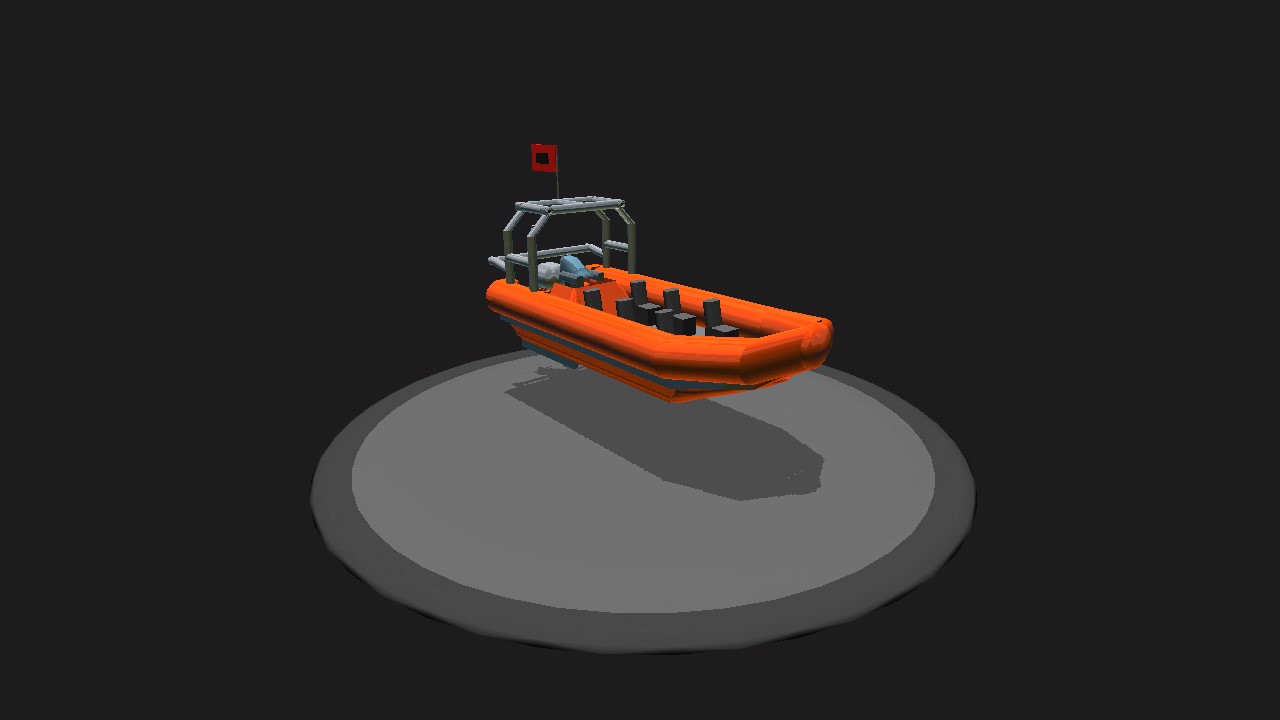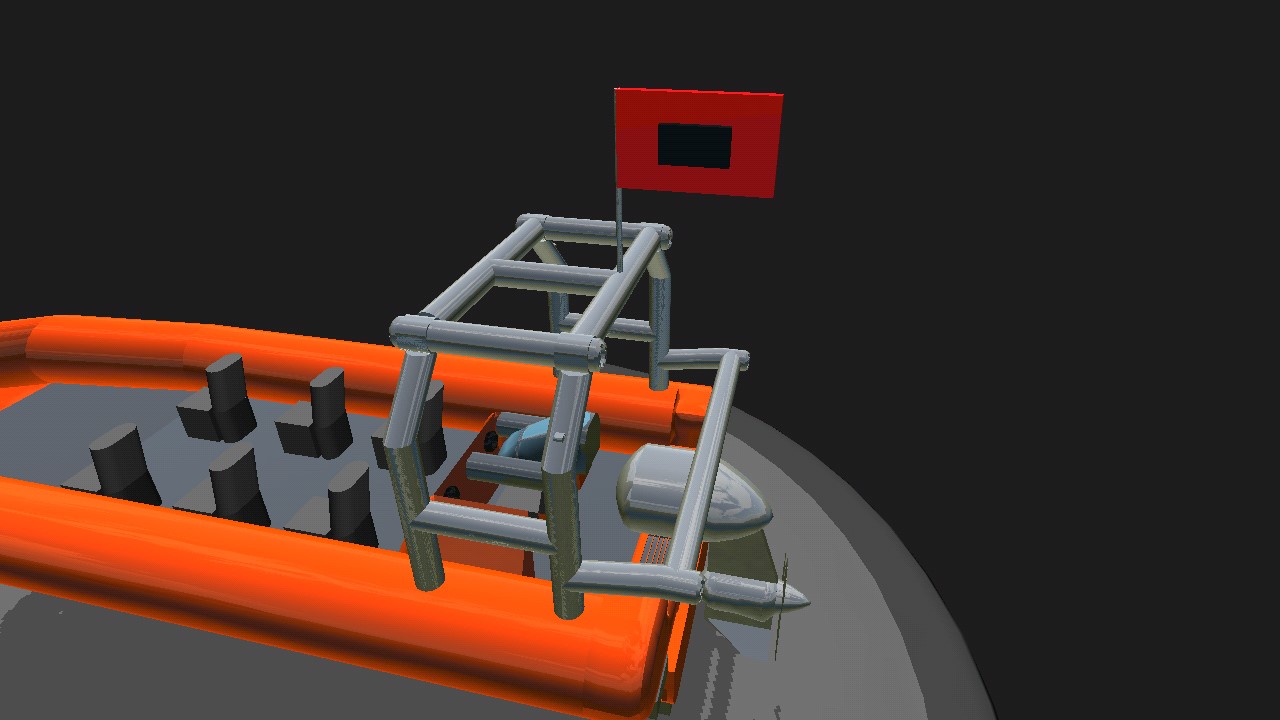I just got back from visiting the USCG base at Grand Isle, La, and decided to finish this RIB I had built before hand. The only reason I hadn’t uploaded it yet is because the slightest turn would make you do barrel rolls.
Features:
Retractable Engine-VTOL up
Modded Propeller-Modded to look like a boat propeller. Take it and add to your subassemblies if you wish.
Beaching Capability-slide VTOL up at full throttle to lift the front of your RIB out of the water and head towards a beach. When you hit the beach, you can throttle down and put the engine down again. No reverse yet.
Storm Warning Flag- the flag on the back of the boat is the storm warning flag for at least the US
Cockpit View-set for drivers perspective
A rigid-hulled inflatable boat, (RHIB) or rigid-inflatable boat (RIB) is a lightweight but high-performance and high-capacity boat constructed with a solid, shaped hull and flexible tubes at the gunwale. The design is stable and seaworthy. The inflatable collar allows the vessel to maintain buoyancy if a large quantity of water is shipped aboard due to bad sea conditions. The RIB is a development of the inflatable boat.
Uses include work boats (supporting shore facilities or larger ships) in trades that operate on the water, military craft, where they are used in patrol roles and to transport troops between vessels or ashore, and lifeboats.
Origins in Britain[edit]
The combination of rigid hull and large inflatable buoyancy tubes seems to have been first introduced in 1967 by Tony and Edward Lee-Elliott of Flatacraft and patented by Admiral Desmond Hoare in 1969 after research and development at Atlantic College in South Wales.
In 1964, Rear-Admiral Hoare and his students at Atlantic College replaced the torn bottom of their 12-foot-long (3.7 m) sailing club rescue inflatable boat with a plywood sheet glued to the inflatable tubes. This proved a successful modification but was rather uncomfortable at speed offshore, and so the floor was rebuilt with a deep-vee bow blending to a nearly flat section stern. This boat was named Atlanta and later that year an Atlantic College RIB was displayed at the London Boat Show.[3]
By 1966 the students had built a further five rigid inflatable boats – Aphrodite (15 ft), Triton (16 ft) and X1–X3. Aphrodite and Triton were for the College’s own use.X1 (16 ft) and X2 (22 ft) were launched in 1965 by Queen Elizabeth II and made under a development agreement with the Royal National Lifeboat Institution(RNLI). They were taken by the RNLI for trials at Gorleston (X1) and Great Yarmouth (X2) from which they returned to Atlantic College in spring 1967. X3 was an experimental vortex-lift hull funded by a private developer and was not greatly successful.
By that time Hoare had concluded that for the conditions under which they operated a boat of around 18 feet long was optimum which led to X4 (launched 1966),X5 and X6 (launched 1967), and X7 to X8 (launched 1968). These boats were used to support the college's sailing activities and also to fulfil the college's responsibility as an inshore lifeboat station for the RNLI – a responsibility it still discharges to this day. At the same time, work started on a smaller series of beach-launchable boats (10 – 12 ft long, designated MX1 – MX6) to support lifeguards on local beaches.
All the above boats’ hulls were built from plywood. In summer 1968, student Paul Jefferies designed and constructed a hull (X10) from fiberglass, which was not a success due to lack of strength. However that development led to the building of Psychedelic Surfer,[4] a twin-engined 21 ft RIB, for John Caulcott, Graeme Dillon and Simon de’Ath to race in the 1969 Round Britain Powerboat Race, in which it was one of the few boats to finish.
From that time, the RNLI transferred development to its research centre in Cowes, who took the Atlantic College designs and developed from them the 21 ft Atlantic 21 class of inshore lifeboats which entered service in 1972 and continued for the next 30 years or so.[5]
The first commercial RIB is believed to be the Avon Rubber Searider which was launched at the January 1969 London Boat Show.
Introduction to North America
In the mid-1970s a hull mould and tubes for 21-foot R-HIBs were sent from Atlantic College to their new sister school being established on the west coast of Canada, the Lester B. Pearson College of the Pacific, atPedder Bay, British Columbia. Three graduates of the Atlantic College who were also trained as RNLI inshore lifeboat coxswains worked at the school during its inaugural year and coached some Pacific College students to build a pair of boats, designated X-27, propelled by twin outboard engines and X-28, propelled by inboard-outboard stern drive. These students were also trained by the graduates to operate these craft as safety boats in support of the college's coastal sailing and diving programs.
During summer, the college loaned their fast rescue craft to the Canadian Coast Guard (CCG), which was introducing rigid-hull inflatables into its new summer seasonal inshore rescue boat service operation. Meanwhile, CCG stations in the Great Lakes began introducing 5.4 metre Avon Seariders at seasonal inshore rescue boat operations in the late 1970s. The CCG inshore rescue boats hired university students to serve as crew, in part due to the success of the student crews operating these ever-buoyant rescue craft at Atlantic and at Pearson College. – From Wikipedia
I really hope you enjoy coxswaining this boat as much as I do. I put a lot of work into this boat and upvoted would be appreciated.
-Thanks, Aeroengineering
Specifications
Spotlights
- This craft has been featured
General Characteristics
- Successors 8 airplane(s) +14 bonus
- Created On Android
- Wingspan 14.8ft (4.5m)
- Length 37.6ft (11.5m)
- Height 20.0ft (6.1m)
- Empty Weight 3,464lbs (1,571kg)
- Loaded Weight 17,354lbs (7,871kg)
Performance
- Horse Power/Weight Ratio 0.057
- Wing Loading 90.0lbs/ft2 (439.4kg/m2)
- Wing Area 192.9ft2 (17.9m2)
- Drag Points 8723
Parts
- Number of Parts 151
- Control Surfaces 1
- Performance Cost 402







Cool
@AeroEngineering Thanks @WalrusAircraft
Thanks @AceMcCloud